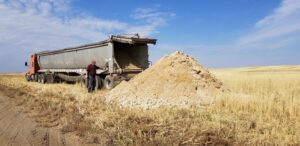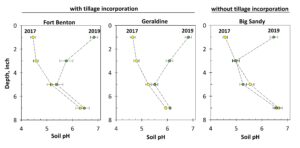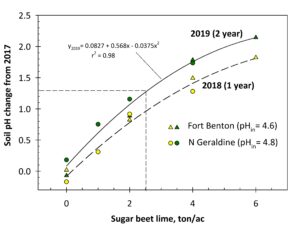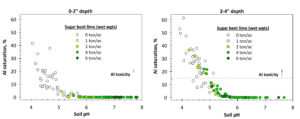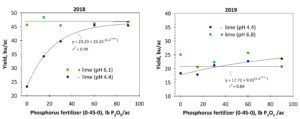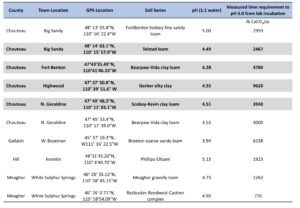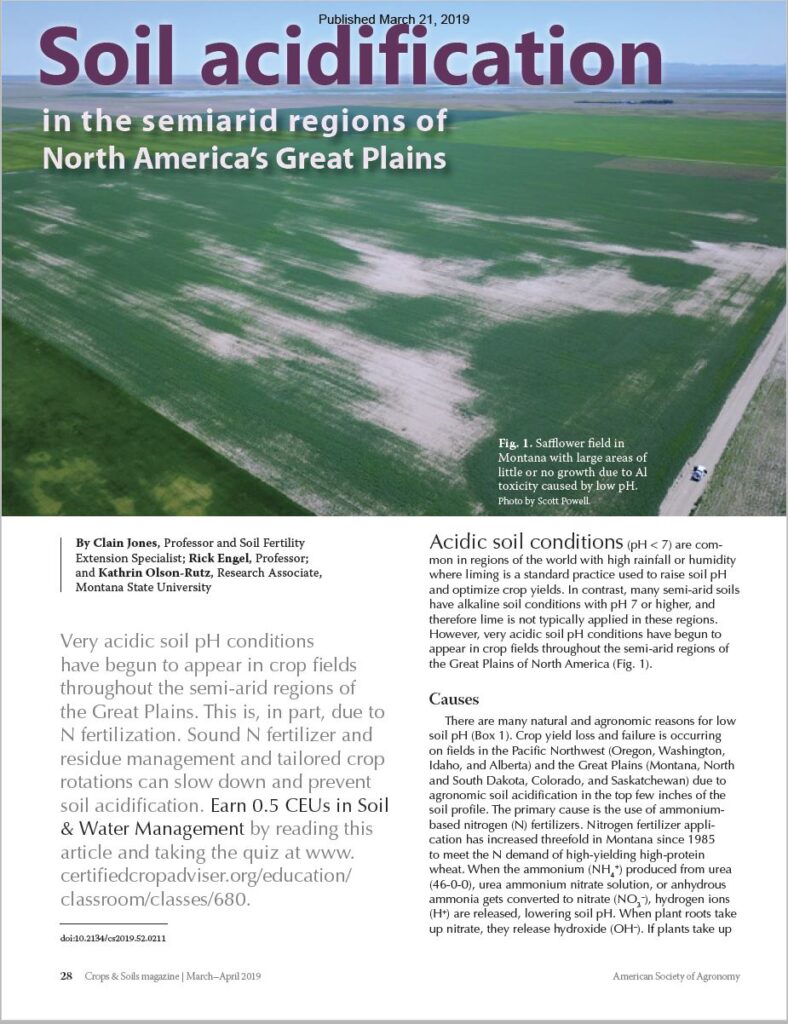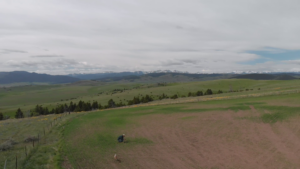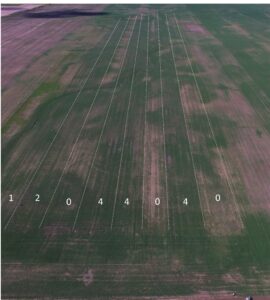Final report for SW17-016
Project Information
Soil acidity has recently become a problem for many dryland producers in Montana and elsewhere in the western U.S., impacting crop production and land sustainability. Without remediation, cereal grains, pulses, and other crops can no longer be grown in some areas because of the detrimental effects of low pH on crop growth, aluminum (Al) toxicity, and rhizobia-pulse crop interactions. In Montana, the problem has been traced to fertilizer N use, which has grown 3-fold since the mid-1980s. Also, the popularity of no-till cropping systems has to lead to stratification of soil pH in the profile with the most acidic layers now appearing near the surface. We established this project to address the emerging problem of soil acidification by examining on-farm remediation with sugar beet (sb) lime, soil buffer tests for estimating lime requirements, soil phosphorus (P) fertility for mitigating Al toxicity, and soil acidity adaptation through the identification of cultivar tolerant crop selections. Our on-farm sb lime rate trials demonstrated this product was efficient for soil pH remediation of two acidic (pH 4.6 and 4.8) clay loam soils provided it was incorporated with tillage. We observed benefits to lentil (Lens culinaris) and yellow pea (Pisum sativum) pulse crops because of improved nodulation by Rhizobia bacteria. Yellow pea seed yield was also greater for sb lime (30.0 bu/ac) than no lime (23.2 bu/ac). We identified an application rate of 2.5 tons of sb lime (wet weight) was necessary to remediate the two acidic clay loam soils to a target pH 6.0. A partial economic analysis of lime application costs indicated that remediating acid soils may require a $100/ac investment. Although this represents a considerable cost input, the costs were modest when viewed over a long-term time horizon, as a single lime remediation application should last 15-20 years (based on other studies). Fertilizer trials revealed that seed-placed P (0-45-0) applied at high rates (i.e., 60 lb P2O5/ac) mitigated Al toxicity effects in durum wheat (Triticum durum) and increased grain yield from 23.3 bu/ac without P to 45.5 bu/ac with P; a similar increase as from lime. Management practices that utilized seed-placed fertilizer-P would be most applicable where a farmer is renting land under a short-term lease agreement and does not want to commit to a lime remediation program that requires a considerable cost input. We identified one soil buffer test, the modified Mehlich protocol that shows promise for estimating lime requirements for acidic soils in Montana. We evaluated up to nine cultivars of spring wheat (Triticum aestivum L.), barley (Hordeum vulgare) , canola (Brassica napus) and field pea (Pisum sativum) in low-pH soils and identified acid-tolerant lines within each crop. We conducted a vigorous extension and outreach program to farmers, ag-consultants, extension personnel and ag-scientists in the region that included three Montana Fertilizer Fact Sheets, eight press articles or newsletters, 39 presentations/webinars, three workshop field days, six on-farm demonstrations, one television production on Montana Aglive, and 1 Youtube video production. Our outreach activities were all targeted at agricultural sustainability (present and future). The cumulative number of attendees at our presentation/webinars was 1585. We estimated our direct contact hours at 1187, in-direct contact hours at >10,000, and conservatively that in the near-term 272 farmers plan to change their management practices because of our study based on survey responses and this number is likely to grow as we continue disseminating results from our study.
1). To develop and execute an on-farm soil acidity remediation and prevention program in central and northern Montana (April 2017-October 2019).
2). Identify soil buffer test methods that provide the best estimate of lime requirements for soils in central and northern Montana (July 2017- October 2019).
3). Identify canola, pea, barley, and wheat cultivars along with crop species grown in cover crop polycultures or cocktails that are best adapted to low pH environments (July 2017-April 2020).
4). Provide agricultural stakeholders with the research results they need to make informed decisions on acid soil mitigation and prevention with both direct engagement, through Field Days, workshops, one-on-one, and indirect contacts including press releases, webpage, radio interviews, and a video, and evaluate the impact of this outreach and engagement effort. Our goal: to reach >500 people directly and have another >5,000 indirect contacts (April 2018– April 2020).
Cooperators
- (Educator and Researcher)
- (Educator and Researcher)
- (Researcher)
- (Educator)
- - Producer
- - Producer
- - Producer
- - Producer
- - Producer
Research
1 – Soil applications of sugar beet lime will be effective at remediating acidity and preventing aluminum toxicity in crops.
2 - Soil testing protocols using buffered solutions will be effective at quantifying lime requirements necessary to remediate acid affected soils in Montana.
3 – Cultivars will vary in their acid tolerance allowing farmers to better select higher-yielding cultivars on acid soils.
4 - Our outreach and engagement strategy will improve economic outcomes for producers who have acid soils.
Objective 1 - On-farm soil acidity remediation and prevention program
We conducted on-farm sugar beet (sb) lime strip-trials at three locations in Chouteau County, 7.4 miles northwest of Big Sandy, 6.3 miles south of Fort Benton and 9.8 miles north of Geraldine. Fort Benton and Geraldine were under a continuous crop management program and Big Sandy was under a fallow-crop system. The sugar beet lime was obtained from Western Sugar Co-op in Billings, Montana and transported to the field sites via semi-trailer truck (Figure 1).
Figure 1. Sugar beet lime was hauled to our field sites by a private hauler in semi-trailer trucks
Each trial consisted of eight strips with three sugar beet lime rates, i.e., 0, 1, 2, and 4-ton material/ac at Big Sandy and Geraldine, and 0, 2, 4, and 6-ton material/ac at Fort Benton. The 0 and 4 ton/ac rates were replicated three times in a randomized complete block design (Figure 2). Individual strips had a long and narrow configuration to incorporate natural variances in terrain and/or background soil pH that occurred across the field sites. Sugar beet lime was applied to each field site in the fall of 2017 using a Stolzfus wet lime applicator provided by Marcus Roddy (producer-advisor representative). A video of the beet lime application has been provided below. The beet lime was incorporated with tillage at Fort Benton and Geraldine, but not Big Sandy (left on surface). Chemical analysis of the beet lime indicated it contained 30% moisture and 55% CaCO3e (wet-weight basis). In 2018, the Big Sandy, Fort Benton, and Geraldine locations were seeded by cooperating farmers to safflower, lentil, and durum, respectively. In 2019, the Fort Benton and Geraldine field sites were seeded to spring wheat and yellow pea, respectively, and the Big Sandy site was in fallow. The dominant soil series at Big Sandy was a Telstad loam and Bearpaw-Vida clay at Fort Benton and Geraldine. Soil pH (0-4 inch) at Big Sandy, Fort Benton and Geraldine before lime application averaged 4.8, 4.6, and 4.8, respectively, but exhibited considerable variance across the field locations. Five soil cores (0-8 inch) were collected at georeferenced locations in fall 2017 (before beet lime application), 2018 (1-yr post), and 2019 (2-yr post), and composited by depth increments of 0-2, 2-4, 4-6, and 6-8 inch.
Figure 2. On-farm sugar beet lime strip-trial plot design used in Chouteau County. Plots were 0.5 mile long at Geraldine and Big Sandy, and 0.3 mile at Fort Benton, Individual plots were 60’ feet wide. Soil cores were collected at georeferenced locations along a transect that ran parallel to the length of each plot with 8 locations per strip and Geraldine and Big Sandy, and 6 locations at Fort Benton.
Objective 2 – Buffer test and lime requirementsWe conducted phosphorus (P) fertility trials with durum wheat in order to evaluate whether seed-placed P would mitigate Al toxicity at low pH field locations. Previous research from the Great Plains has shown that boosting P fertilizer rates, particularly as band applications with- or near the seed provides a short-term approach for mitigating soil acidity problems. Therefore, we conducted on-farm small plot trials at two locations in 2018 and 2019 to evaluate the impact of P fertilizer management on crop tolerance to acidity. These trials were integrated with our cultivar-crop species trials discussed under Objective 3 and included two lime management levels (0, 5-ton Aglime/ac) and four P rates (0, 15, 30, 60, and 90 lb P2O5/ac). The treatments were replicated four times in a split-block randomized complete block design.
Our goal was to identify soil chemical buffer tests among four published protocols to determine which would provide the best estimate of lime-requirement for acid-affected soils of central and northern Montana. This objective was approached by collecting surface soil samples (0-4 inch) from ten agricultural fields/locations from central and northern Montana. The soils were dried and processed for 1) a laboratory incubation with calcium carbonate (CaCO3) to determine the theoretical lime requirement necessary to achieve a targeted soil pH (e.g., pH 6.0); and 2) analysis of lime requirements utilizing four established soil buffer protocols, specifically, Adams and Evans test (Adams and Evans, 1962), Woodruff test (Gavlak et al., 2005), modified Mehlich test (Hoskins and Erich, 2008), and Sikora test (Sikora, 2006). Agricultural fields targeted for sample collection all had soil pH <5.2 and represented different soil series (defined from USDA-NRCS soil surveys) that were common to Montana and representative of soils under crop production. The laboratory incubation with CaCO3 was performed over 90 days using seven application rates (0, 2000, 4000, 6000, 9000, 12000, and 15000 lb CaCO3/ac) with each soil. Regression analysis was used to determine the theoretical lime requirement for each soil to achieve the target pH 6.0 value. The predicted lime requirement to achieve the target pH 6.0 was then estimated using each of the four soil buffer protocols. Regression and correlation analysis were used to compare predicted lime requirements (buffer tests) with theoretical lime requirements determined from the CaCO3 incubation.
References
Adams, F., and C. E. Evans. 1962. A rapid method for measuring lime requirement of red-yellow podzolic soils. Soil Sci. Soc. Am. Proc. 26:355-357.
Gavlak, R., D. Horneck, and R. O. Miller. 2005. Soil, Plant and Water Reference Manual for the Western Region. 3rd ed: 50–57.
Hoskins, B. R., and M. S. Erich. 2008. Modification of the Mehlich Lime Buffer Test. Comm. Soil Sci. Plant Anal. 39:2270-2281.
Sikora, F.J. 2006. A buffer that mimics the SMP buffer for determining lime requirement of soil. Soil Sci. Soc. Am. J. 70:474–86.
Objective 3 - Canola, pea, barley, and wheat cultivars trials screening for pH tolerance /susceptibility.
We screened canola, pea, barley and spring wheat cultivars adapted to Montana’s dryland agriculture for susceptibility and resistance to low pH and/or aluminum toxicity. Our approach was to embed replicated small plot trials inside of fields that were identified as having production-related problems due to soil acidity. Two locations were identified with pH ≤5.2 on private farms near Fort Benton and Geraldine in central Montana. The study ran for two growing seasons (2018 and 2019) and consisted of up to nine entries per crop species and two pH management levels (-lime, +lime). Treatments were replicated four times in a strip-split-plot design with pH management as main-plots, crop species as sub-plots, and cultivar selection as sub-sub-plots. The four crop species were seeded into individual plots (5 x 20 feet) with a cone seeder. The lime material was fine-grind agricultural limestone or Aglime (i.e., dolomitic limestone, 99.2% passing through a #100 sieve). This material was purchased in fall 2017, hauled to our field sites in sacks (Figure 3), and spread to the +lime strips at 5 ton/ac using the Stoltzfus wet-lime applicator (Figure 4) with the participation of our cooperating farmers.
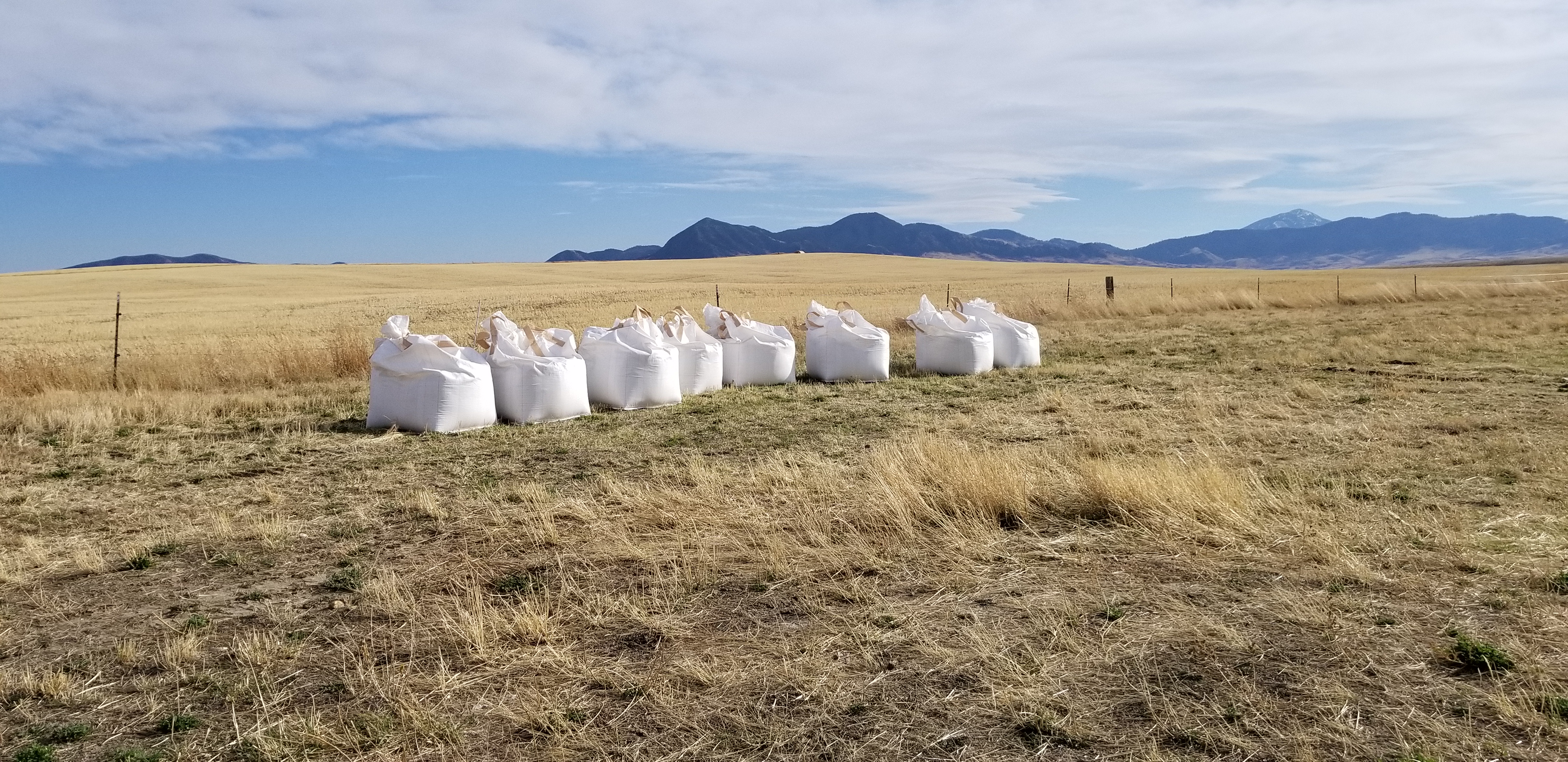
Figure 3. Fine-grind and reactive agricultural limestone was transported to our field sites in 1-Ton (short) sacks.
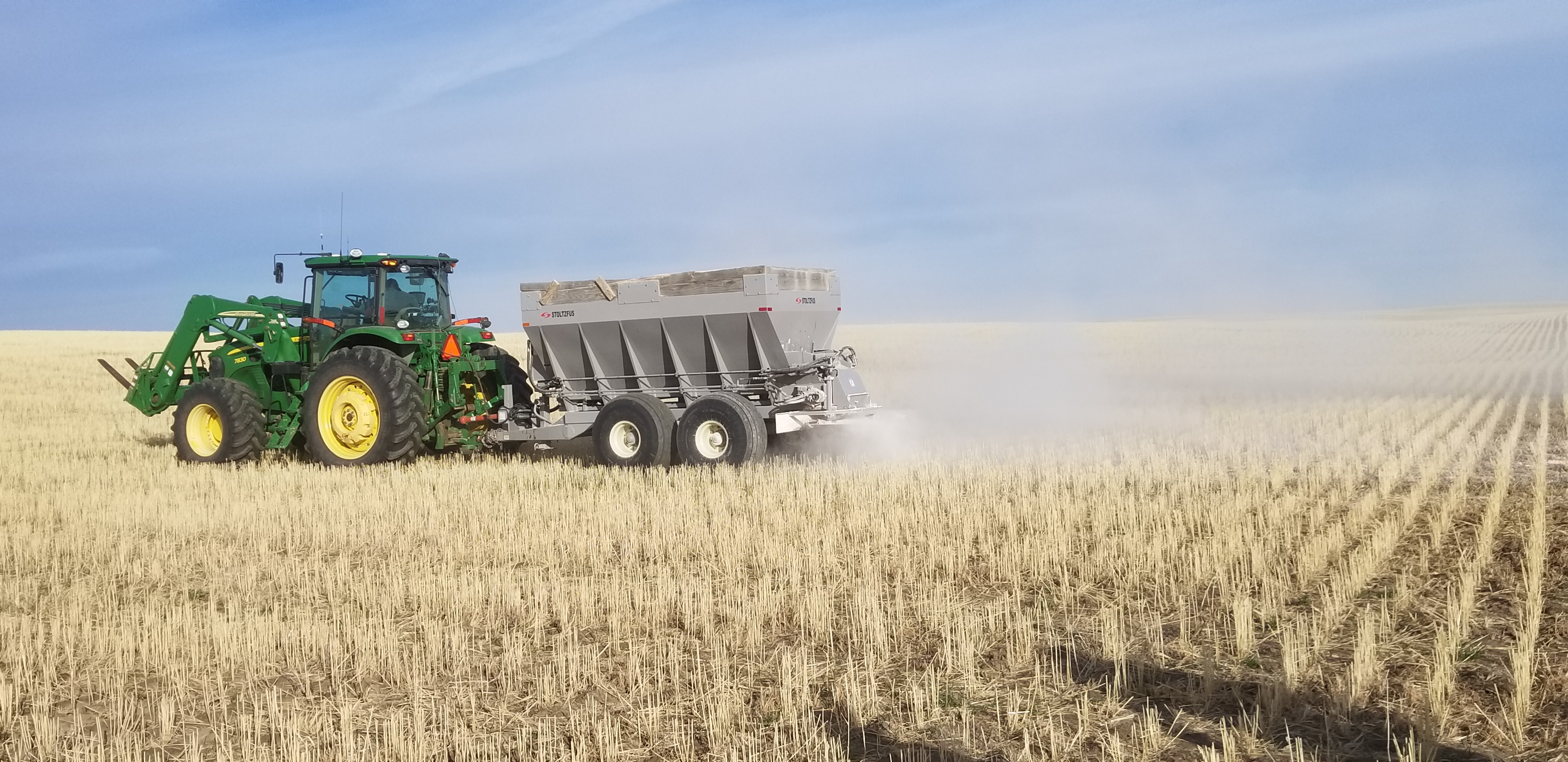
Figure 4. Lime application with the Stoltzfus wet-lime applicator. Lime material was incorporated with the surface soil shortly after application.
Objective 4 - Outreach to agricultural stakeholders, including evaluation
We provided agricultural stakeholders with the research results they need to make informed decisions on acid soil mitigation and prevention by direct engagement at Field Days, workshops and conferences, agricultural association annual meetings, one-on-one contact, and through indirect contacts achieved through printed and online material, video and radio. We partnered with the Chouteau Conservation District, NRCS, Chouteau County Extension (Tyler Lane Extension Agent), and the Montana Salinity Control Association (Jane Holzer Program Director) to maximize turn-out at project sponsored field days which were held at our crop cultivar trials near Fort Benton (Objective 3). In the winter of 2018 2019/20, we held a workshop in Chouteau County for producers and ag professionals, summarizing the results of our study. Most importantly, at Field Days and at this workshop, we asked the farmer-collaborators to discuss their observations and experiences with soil acidity given that farmer to farmer education is often the most impactful. In addition, Dr. Jones shared project results with colleagues in the western region at the Western Nutrient Management Conference in 2019 and continues to share results from this project by emails to MSU agricultural Extension agents, NRCS personnel, and Rocky Mountain Certified Crop Advisers. He will present results from incubation and liming studies in a Soil Science Society of America annual convention symposium in November 2020l.
Evaluation Plan
Field day and workshops were evaluated using the WSARE-approved Research and Education Outreach Survey with the added question: “What would have made this program more useful to you?” To assess project impact, we conducted a mail survey in the winter of 2020 to 300 producers (selected randomly from FSA lists to determine, 1) if producer knowledge and understanding of the acidification process and mitigation options have improved, and 2) if producer practices have changed or are more likely to change because of this study. We also did an electronic survey of Ag. Extension agents and Certified Crop Advisers to determine their familiarity with soil acidification and if/how this project has changed their recommendations to producers.
Under Objective 1
Soil pH and Al impacts from liming
We found that sugar beet lime application raised soil pH in the 0-2- and 2-4-inch depth layers if incorporated with tillage (Figure 5). Four ton/ac beet lime application increased soil pH 2.2-2.4 and 1.2-1.3 units in the 0-2- and 2-4-inch depth layers at Fort Benton and Geraldine. Sugar beet lime was left on the surface and not incorporated with tillage at Big Sandy. Soil pH increased only in the 0-2-inch depth layer at this location, and even this observed effect was likely an artifact of the sampling approach as considerable undissolved lime was mixed with soil material in the 0-2 inch sample cores. In summary, our results demonstrated that beet lime does not readily wash into the soil in Montana’s semiarid climate, and that incorporation with tillage was necessary to correct soil acidity in the surface 4 inches of soils.
Figure 5. Soil pH depth-profile in fall 2017 (before) and 2019 (after) sugar beet lime application (4 tons/ac) at Fort Benton (incorporated with till), Geraldine (incorporated with till), and Big Sandy (no-till).
We found sugar beet lime applications (fall 2017) at Fort Benton and Geraldine raised soil pH (0-4 inch depth) over a 1-year and 2-year time window according to the curvilinear relationship of Figure 6. The dominant soil series at both field sites was Bearpaw-Vida clay loam, and so it was not surprising that the pH change with lime was similar at the two locations. Overall, the relationships demonstrated beet lime was effective at ameliorating soil acidity, and that most of the pH changes occurred in the first year if the lime material was incorporated with tillage and therefore validating Hypothesis 1. Sugar beet lime requirements to raise soil pH by 1.3 units to a target pH of 6 was approximately 2.5 tons/ac, or 2750 lb CaCO3/ac. We estimated the beet lime application costs at $100/ac assuming a transport cost of beet lime to the farm at $35/ton, and field applications cost $12/ac for spreading and tillage incorporation. While our $100/ac estimate represented a considerable cost input, we believe the costs were modest when viewed over a long-term time horizon (e.g., 15-20 years), meaning annualized costs of closer to $5 to $7/ac per year.
Recently, we have created models (from related long-term cropping system investigations and not supported by WSARE) of soil pH change vs. cumulative fertilizer-N inputs. Our models indicate that the acidification process from fertilizer-N occurs slowly over time and is directly related to the cumulative amount of fertilizer-N applied. For example, a 14-yr study in Montana on a silt loam soil found that approximately 2200 lb/ac of fertilizer-N was required to lower pH 1.0 unit. Therefore, presuming soil has been restored to pH 6.0 with lime, it may take many years before cumulative fertilizer-N inputs can again acidify the soil to a pH < 5, and crop Al toxicity problems return (discussed below).
Figure 6. Soil pH change from 2017 to 1- and 2-years after application of sugar beet lime.
Aluminum toxicity in crops is typically found in soils with pH < 5 because of the increased solubility of Al-containing minerals in the soil. A strong relationship was found between soil Al saturation percentage in (or % of exchange sites occupied by Al) and pH at our Fort Benton and Geraldine beet lime field sites (Figure 7). The relationship in these figures is typical of most mineral soils and illustrates that crop available Al rises sharply as pH falls below 5. Crop Al toxicity symptoms have been associated with soil Al percentages that exceed 15%, although a precise critical level will be impacted by crop species and cultivar selection. The results from our trials indicate the application of beet lime was effective at bringing Al saturation percentages below this threshold for all of our soil samples in the 0-2-inch depth and most of the samples in the 2-4 inch depth.
Figure 7. Aluminum saturation percentage vs. soil pH relationships in the 0-2" (left) and 2-4" (right) depth soil layer for sugar beet lime applications (tons material/ac) at Fort Benton and Geraldine in the fall 2019 (2-year post-lime application).
Crop growth and liming
In 2018, we observed obvious differences in growth of lentil at our sugar beet lime strip-trial near Fort Benton. Lentil top growth was greener, and biomass was greater in areas receiving lime compared to the non-limed area (Figure 8). Also, an aerial drone flight on June 24, 2018 revealed the limed strips were visible from the air using NIR imagery, though differences in growth between adjacent lime and non-lime areas were not apparent along the entire field transect (Figure 9). The benefits to lentil growth, biomass and color were believed to reflect greater Rhizobia activity that translated to improved nitrogen nutrition. Surprisingly, these early season growth differences did not translate to greater seed yield at harvest, likely because yield was more water limited than N limited.
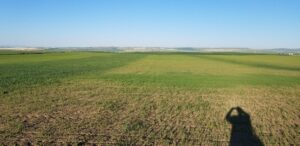
Figure 8. Visual differences in lentil growth were apparent from the sugar beet lime applications at Fort Benton with the green strips receiving lime vs. the chlorotic, non-limed areas. Spring soil pH (0-4 inch depth) was 4.7 in the non-limed strips and 5.9 in the limed (4 ton sugar beet lime/ac) strips. The photograph was taken June 14, 2018.
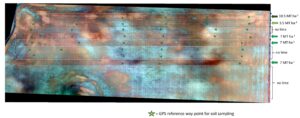
Figure 9. Aerial NIR drone imagery of the lentil field on June 24, 2018, revealed darker red coloration in strips receiving sugar beet lime relative to strips without lime.
Similarly, in 2019 we observed yellow pea growth at Geraldine was more robust where lime was applied (Figure 10). Unlike lentil, seed yield was significantly improved by lime (non-lime = 2.73 bu/ac vs. limed =30.6 bu/ac). As observed in our lentil trials, the benefit of liming was believed to result from improved Rhizobia activity, nodulation, and N-nutrition of these pulse crops. Inspection of yellow pea root samples found large differences in nodule numbers between pea on limed and non-limed fields (Figure 11). These results were not surprising as Rhizobium nodulation is known to be sensitive to soil acidity. The soil pH of the non-lime areas was 4.7 and in contrast to a pH > 6 in our limed strips.
 |
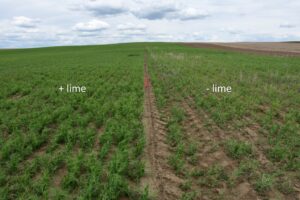 |
Figure 10. Yellow pea growth and coloration was improved at Geraldine with the application of lime on June 05, 2019 (left) and June 19, 2019 (right)
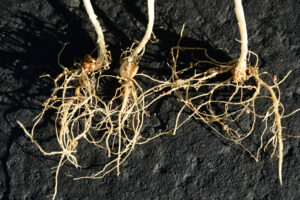 |
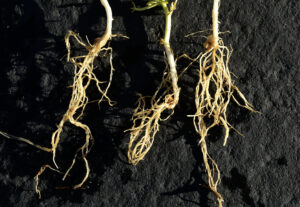 |
Figure 11. Yellow pea roots exhibited differences in nodule abundance between areas with lime (left) and without lime (right). June 19, 2019.
Seed-placed P fertilizer trials
In 2018, we observed a large growth response to P fertilization in durum where the soil pH was not amended with Aglime application (Figure 12). Grain yield was affected by the interaction of lime and P fertilizer (Figure 13). Briefly, seed-placed P fertilizer mitigated Al toxicity symptoms and improved grain yield by 22 bu/ac over unfertilized controls where lime was not applied. Conversely, durum was unresponsive to P fertilizer when lime was applied to correct soil acidity. In 2019, a similar response by durum to P fertilizer was evident early in the growing season at the Highwood Bench field site. However, two hailstorm events during the growing season reduced yield by approximately 50% and minimized the yield response to P fertilizer. Our results indicate that seed-placed P fertilizer provides a method for mitigating Al toxicity at field sites with acidic soils and can help even at field sites with very high soil P levels (50 – 83 ppm). The response to P fertilizer is not associated with a nutrition benefit as it occurs in soils that test very high in available P, which was the case in both 2018 and 2019. Rather, the benefit results from a reduction in Al concentration in the root tips as a result of Al-P precipitation (reference). The fertilizer strategy of placing P with the seed to mitigate Al toxicity in crops should be viewed as a short-term approach to manage acidic soils as soil pH is not remediated. In Montana, this strategy might best be suited for a situation where a farmer is renting land under a short-term lease agreement.
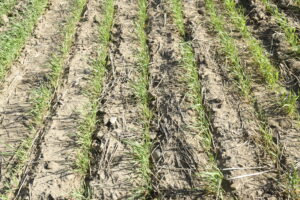 |
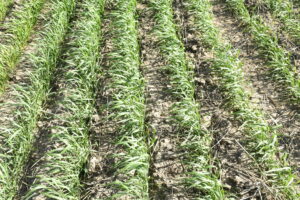 |
Figure 12. Seed-placed P (right) resulted in more vegetative growth and higher durum yields than non-fertilized P areas (left) at our field site on the Highwood Bench. Soil pH was 4.4 in the plots that did not receive Aglime.
Figure 13. Durum grain yield on the Highwood Bench was improved with P fertilizer under acid soil conditions (-lime) but was not affected where soil acidity was mitigated with lime applications. Olsen soil P level = 50 ppm in 2018 and 83 ppm in 2019 (very high).
Under Objective 2
We collected soil samples for the lime-requirement incubation study in fall 2017 from ten locations in Montana (Table 1). The ten soils were treated with seven rates of CaCO3 and incubated for 90 days in small pots at field moisture capacity. Soil pH was measured at the conclusion of the 90-day incubation experiment and plotted against the CaCO3 application rate (Figure 14 – left – only four soils shown). The observed CaCO3 (or measured lime requirement) to achieve a target pH of 6.0 was determined by the interpolation of soil pH vs. CaCO3 rate curves. We then estimated lime requirement using the four buffer protocols. Pearson correlations of predicted (buffer protocols) vs. measured lime requirement was 0.84, 0.76, 0.66, and 0.63 for the modified Mehlich, Sikora, Adams-Evans, and Woodruff buffer protocols, respectively, with one outlier soil (Gerber silty clay) deleted from this analysis. The modified Mehlich protocol provided the best estimates of measured lime requirement. A plot of lime incubation (measured or observed) vs. modified Mehlich lime (predicted) requirement shows the predictions (y-axis) were closely aligned to the observed (or measured) lime requirements (x-axis) as evidenced by their proximity to the 1:1 line (Figure 14 - right). The Gerber silty clay soil behaved differently than the nine other soils we examined. The incubation lime requirement for the silty clay was much higher than predicted by the modified Mehlich protocol as well as for the three other buffer protocols. The reason why the Gerber soil behaved so differently may be related to a large drop in pH observed for the 0 CaCO3 treatment over the incubation period (pH0 day = 4.55 vs. pH90day = 3.88). It is possible Al3+ ions may have desorbed from the soil and then were ‘hydrolyzed’ creating more acidity than would be predicted by the buffer tests.
Table 1. Series name, location, pH (1:1 water), and measured lime requirements to a target pH 6.0 of ten soils used in the lime incubation experiment. Four highlighted series appear in Figure 14 (left).
   |
 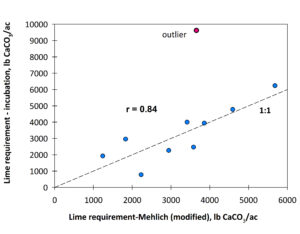 |
Figure 14. Soil pH after a 90-day lab incubation as affected by CaCO3 (left). Only four soils shown for clarity. Predicted lime requirements to pH 6.0 using the modified Mehlich6 buffer vs. measured lime requirements determined from the 90-day incubation.
Under Objective 3
In 2018, we conducted Aglime (+,-) x cultivar selection trials with four crop species (pea, canola, spring wheat, and barley) at two farms (Geraldine and Highwood) to determine potential benefits to lime applications and to identify selections with tolerance to soil acidity. At Highwood in 2018, early and mid-season differences in growth from lime applications were visually evident in barley, pea, and spring wheat with greater biomass occurring in areas receiving lime. However, the greater top growth likely created more drought-stress at grain-fill resulting in smaller mature kernel sizes and compromised yield. This phenomenon was particularly evident in barley, which actually showed a significantly lower yield with +Aglime vs. -Aglime control. At both locations in 2018, certain cultivars of pea and canola incurred severe (>15%) pod shatter losses.
In 2019, we conducted Aglime (+,-) x cultivar selection trials with four crop species (pea, canola, spring wheat, and barley) at Highwood, and two crop species (spring wheat and barley) at Geraldine. Residual herbicide issue prevented the seeding of canola and pea at Geraldine. At Highwood, two mid-season hailstorms severely damaged all crops, but in particular pea and canola. However, it was assumed that hail damage and aluminum toxicity did not interact to affect yield or quality. Yield and quality for limed and non-limed plots were analyzed separately across site-years, with cultivar as a fixed effect and rep nested in site-year as a random effect. In Table 2, yield and quality results are summarized for cultivars that were represented in three (pea, canola) and four (wheat, barley) site-years.
Table 2. Lime-amended (+Aglime) and unamended (-Aglime) protein (oil for canola), protein or oil yield (yield x oil or protein) and seed yield for cultivars and experimental lines of barley, canola, pea, and wheat. Results are averaged across three (pea, canola) and four (wheat, barley) site-years.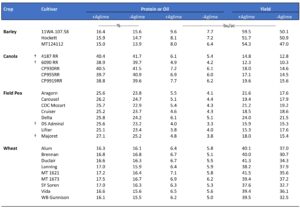
Under Objective 4
Outreach activities and outcomes are summarized in the Education and Outreach section. Briefly, our activities have included 39 oral presentations including talks to growers, fertilizer dealers, private consultants, and scientists at international and regional meetings. Also, we have presented our research project on Youtube, Montana AgLive and Yellowstone Public Radio (https://www.ypradio.org/post/worm-november-6-2019#stream/0). Our research has been reported in print media including Montana Grain News, The Prairie Star, Crops & Soils Magazine, and Montana Fertilizer eFacts.
We had 1539 direct contacts over the course of the project totaling 1189 direct contact-hours (Table 10) and over 10,000 indirect contacts. In the three events with attendees being predominantly producers (>80% of participants), on average, each person would share their new information with 9 others. If we include the presentation dominated by certified crop advisers in the audience, on average each attendee would share information with 38 other people. In the three events where the majority of attendees were producers, 81% said they would likely change management practices as a result of what they learned that day.
Objective 1
We successfully executed a soil acidity remediation and prevention program via our on-farm lime strip trials conducted at three farms in Chouteau County. This portion of the study found that sugar beet lime was an effective product for remediating acidic clay loam soils (pH 4.6 and 4.8) with the application of 2.5 tons of lime material per acre to a target pH 6.0. In addition, we identified lime requirements for similar soils to other targeted pH levels. Our belief (Hypothesis 1) that soil applications of sugar beet lime would be effective at remediating acidity and preventing aluminum toxicity in crops was found to be correct.
Our study identified the importance of incorporating lime material with tillage to achieve the most effective result. Without tillage, lime material does not readily wash into the soil profile in Montana's semiarid climate. Also, we measured soil organic matter (or soil organic carbon) in the top 8 inches before and after lime incorporation at 2 sites. The single tillage to incorporate lime did not change soil organic matter. This conclusion is important as Montana dryland farms are dominated by no-till management and no-till farmers are sometimes reluctant to conduct an occasional tillage event because of the perceived effects on soil organic matter loss. Our study found lentils and yellow pea growth was likely improved by liming because of benefit to Rhizobium. Rhizobium growth, survival and abundance, and nodulation (which is responsible for N fixation by legumes) of pulse and other legume crops decrease as pH falls below 6. At one lime strip trial location, yellow pea seed yield was significantly greater with sugar beet lime (30.6 bu/ac) applied at 2 or 4 ton/ac compared to 0 lime control (23.7 bu/ac). This yield increase equates to $42-65 per acre more income for the farmer assuming a pea price range of $6.25-9.72 per bushel. Pulse crops (particularly lentil and peas) are now grown on 1,000,000 acres of cropland in Montana and are the most important alternative crop to cereal-based rotations.
We found the application of high rates of seed-placed P fertilizer provides an alternative method to mitigate Al toxicity and improve the production of cereal crops in the absence of liming. At one farm location with soil pH 4.2, seed-placing 60 lb P2O5/ac ($23 cost @ $0.38 per lb of P2O5) increased grain yield by 22 bu/acre over the 0 P controls where lime was not applied. In Montana, this strategy might best be applicable where farmers do not want to assume the cost of liming plus incorporation with tillage because they are renting land under a short-term lease agreement. Currently, approximately 25% of Montana's dryland acreage is managed under a rental agreement (source Aton Bekkerman, former Associate Director of MT Agricultural Experiment Station, Associate Professor Agricultural Economics).
Objective 2
Our study identified the modified Mehlich buffer protocol as being the most promising soil test for estimating lime requirements of Montana soils among the four protocols tested. Although the correlation between the predicted lime requirement by modified Mehlich and observed lime requirement (laboratory incubation) was strong (i.e., r= 0.84), our study was limited to only ten soils. A more robust analysis with additional soil series needs to be conducted to better determine, 1) the reliability of this soil test protocol and where a particular set of soil properties make the test undependable as evidenced by our one soil series outlier (i.e., Gerber silty clay) and, 2) provide a better calibration (via regression analysis) of the modified Mehlich method to observed lime requirements of Montana soils. Hypothesis 2 stated that soil testing protocols using buffered solutions would be effective at quantifying the lime requirements of Montana soils. Our study was able to conclusively confirm this hypothesis.
Objective 3
Up to nine lines of spring pea, canola, wheat, and barley were established in limed and non-limed low-pH soils with representation in three (pea, canola) and four (wheat, barley) site-years. Our results support the hypothesis that cultivars vary in their acid tolerance allowing farmers to better select higher-yielding cultivars on acid soils (Hypothesis 3). Assessed across site-years, pairwise comparisons revealed that the canola lines ‘CP930RR’, ‘CP955RR’, and ‘CP9919RR’ each out-performed ‘6090 RR’ (p < 0.05) for seed yield and oil yield (seed yield x oil content), and that the dual-purpose forage/grain variety of field pea, ‘Delta’, out-performed both ‘Lifter’ (p < 0.1) and ‘DS Admiral’ (p < 0.1) for protein yield (yield x protein), and produced more seed than both ‘Lifter’ (p < 0.1) and ‘Majoret’ (p < 0.05) in unlimed, low-pH conditions. Importantly, significant pod shatter losses were observed for ‘6090 RR’, ‘DS Admiral’, and ‘Majoret’ in 2018 (Table 2). The experimental barley line ‘MT124112’ had lower protein than both ‘Hockett’ (p < 0.05) and ‘11WA.107.58’ (p < 0.001) but produced an equivalent amount of seed in low-pH soils. The wheat line ‘Brennan’ was out-performed by ‘Alum’ (p < 0.1) for seed yield and by the experimental line ‘MT 1673’ (p < 0.1) for protein yield in non-limed, low-pH conditions.
Objective 4
We conducted a very intensive extension and outreach program to complement this project, and successfully completed the activities identified in our project proposal including direct and indirect engagement as described below under the Educational section. Our project goal, i.e., to reach >500 people directly (1585 measured) and >5,000 people indirectly (>10,000 estimated), was achieved. Given the yield and economic loss from soil acidity that we witnessed first-hand during this project, we believe our outreach and engagement strategy will improve farm economic outcomes for producers who have acid soils (Hypothesis 4).
Research outcomes
Education and Outreach
1 Soil acidification webpage http://landresources.montana.edu/soilfertility/acidif/acidif-bckground.html
1 Video Acidification of Cropland Soil: Impact, Causes, Solutions. Features Dr. Clain Jones and testimony by one of our farmer-cooperators. June 29 2020 https://youtu.be/cjWneDQVyV8 424 views by July 21 2020.
2 Television production -Montana Ag live - Dr. Clain Jones was featured guest speaking about soil acidity, April 29, 2018.
3 Interviews
• Yellowstone Public Radio https://www.ypradio.org/post/worm-november-6-2019
• USA Dry Pea & Lentil Council
https://www.facebook.com/USADPLC/videos/2225552174419601/UzpfSTEyNzUwODI4NDI2NDgxMzM6Vks6MjYxMzg2MTEwODcwNTgwMA/
• Northern Ag Network https://soundcloud.com/user-678192412/61218-full-interview-with-msu-extension-soil-fertility-specialist-clain-jones-on-soil-acidity
Participation summary:
Our education and outreach activities, including oral presentations, MSU Fertilizer Fact sheets, popular press articles and newsletters, and Youtube video production are highlighted below in tables and bullet form below.
Table 3. Summary of oral presentations given this project's inception including one Youtube presentation.
 |
 |
Presentation Evaluations
We measured our outreach impact by asking attendees to evaluate our presentations. Our major goals were to determine 1) if the producer and certified crop advisor knowledge and understanding of the acidification process and mitigation options had improved, and 2) if producer practices would likely change because of this study. Based on the evaluations of six presentations, 99% of the attendees felt their understanding of soil acidification was improved, and 84% of the producers said they would likely change some aspect of their farm management as a result of what they had learned that day. We also asked our presentation attendees if-, and if so, with about how many people, they would likely share information/knowledge gained at our talk. On average, producers would share the information with 9 other people, and certified crop advisers would share the information with 38 others. Of the cumulative 443 attendee responses (6 presentations), almost 40% indicated they would share information they gained with others, reaching an additional 1642 people.
Surveys
In the fall/winter of 2019/2020, we mailed a survey to 300 randomly selected farmers in Daniels, Chouteau, Valley, Yellowstone and Pondera, MT, counties where we conducted outreach events. Each county has fields with acid soils. We received 53 completed surveys, despite 2 reminders. Based on the written comments by a few, such as ‘Not up to date on this. So I did as I felt’, and ‘Farming 40 yrs and never thought about most of these questions on our soil, so we have no knowledge to answer’, we believe the low response rate was an indication of unfamiliarity or low interest with the topic. However, 74% of the respondents had heard about soil acidification. Of the ones who specifically recall MSU Extension as the source of information, 50% said they’ve had a moderate to a large change in their understanding of the issue. The respondents’ level of concern over the issue closely matches whether they have or have not seen acidification happening in their fields. Oral presentations at workshops and field days, MSU Extension materials, and newspaper/newsletter/trade journals are the preferred means by which producers get the information they trust.
We also surveyed extension agents and crop advisors because they often provide management advice to individual farms. We conducted a shorter online survey of all MSU Agricultural Extension Agents (EAs) and 90 MT and WY Certified Crop Advisers (CCA). We received responses back from 16 EAs (34% of total) and 16 CCAs (17% of total). Interestingly, EAs predominantly received their information on soil acidification from MSU, whereas CCAs obtained their information from a mixture of sources, including MSU. The survey results found our WSARE project improved knowledge and impacted practices (Table 4). Our survey identified four EAs and five CCAs who each knew two and five farmers, respectively, who changed their management practices as a result of our project. We asked what specific management changes have been made based on our outreach; a range of practices were identified including conducting more soil pH tests, sampling the upper 3 inches of soil compared to traditional 0-6 inch depth sampling, applying P fertilizer with the seed, reducing fertilizer-N use, including more pulse crops in rotations, utilizing split and variable-rate fertilizer-N applications, liming soil, and selecting cultivars more tolerant to low pH.
Table 4. Online survey results from MSU Agricultural Extension Agents (EA) and Montana and Wyoming Certified Crop Advisers (CCA).
MSU Extension Fertilizer Fact Sheets
- Soil acidification: An emerging problem in Montana. http://landresources.montana.edu/fertilizerfacts/documents/FF78SoilAcidifIntro.pdf
- Soil Acidification: Mitigating Yield Loss with Seed-placed Phosphorus Fertilizer and Aglime
- Soil acidification: Remediation with sugar beet lime
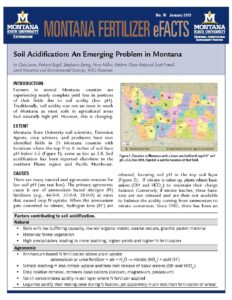 |
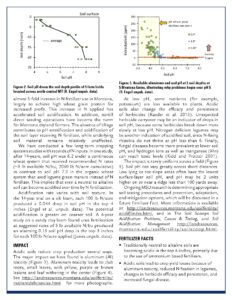 |
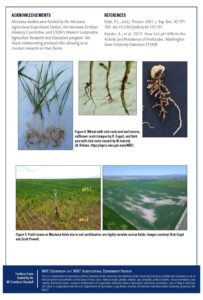 |
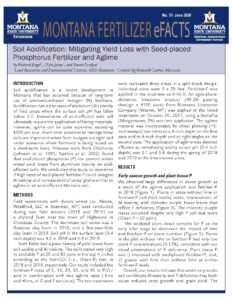 |
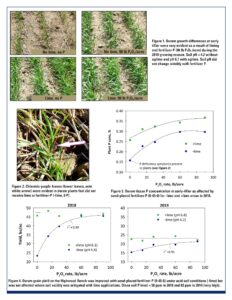 |
 |
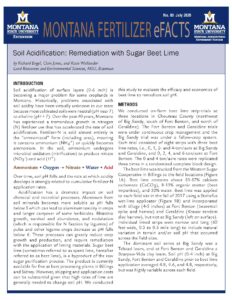 |
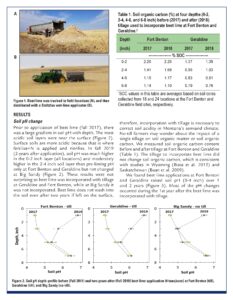 |
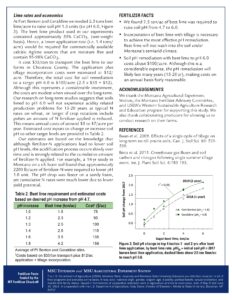 |
Published press popular press articles and newsletters
-
Montana Grain News – Soil Acidity: Emerging Issue That Requires Scouting – May 2018
- FARM 406. Soil Acidity: An Emerging Issue that Requires Scouting. Fall 2018 issue (https://www.e-digitaleditions.com/i/1041839-farm406-fall-2018/17?m4=) see below (cover page only)
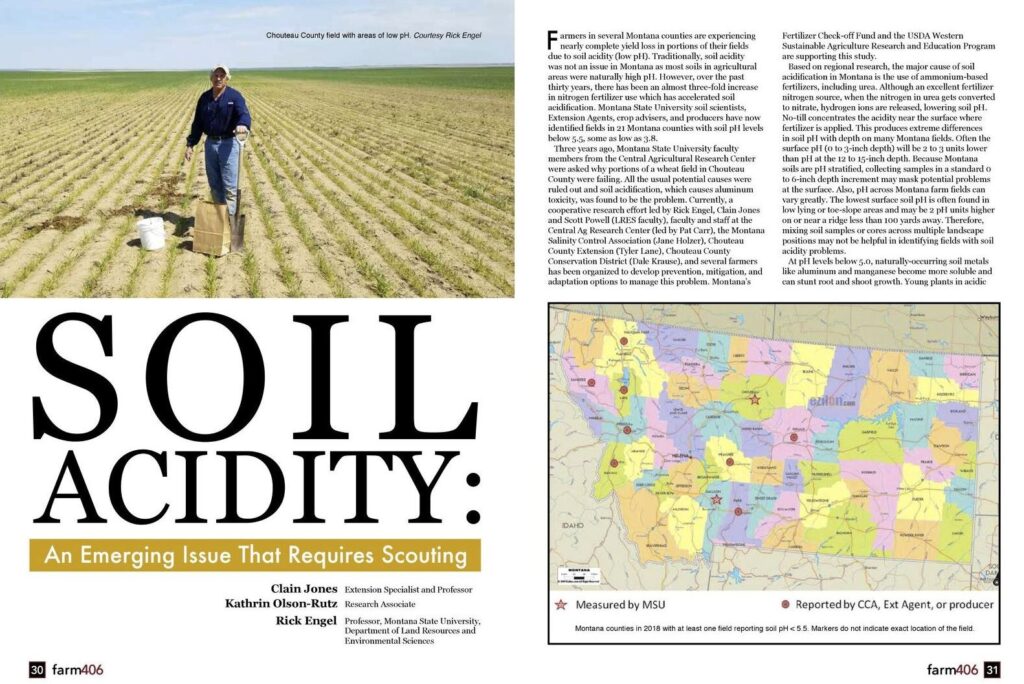 |
- Acid Soil: Prevention may be cheaper than cure - by Meryl Rygg McKenna in Montana Grain Growers Association newsletter and MT Salinity Control Association newsletter
- Beware: Soil acidity. May 2019. Montana Salinity Control Association Newsletter
-
The Prairie Star – Management solutions to low pH soils and yield loss – June 8, 2018
-
The Prairie Star – Yellowing leaves, club roots, yield loss may be low soil pH – June 8, 2018
-
Montana NRCS - https://www.nrcs.usda.gov/wps/portal/nrcs/mt/newsroom/features/soil+acidification+a+growing+concern+for+montana+farmers/
- Jones, C., R. Engel, and K. Olson-Rutz. 2019. Soil Acidification in the Semi-arid Regions of the Northern Great Plains. Crop & Soils Magazine. March-April. p 28-30,56. - this article is being used by Dr. Jay Goos Introductory Soils Class at North Dakota State University (see below - cover page only).
Indirect contacts are estimated to exceed 10,000 via publications and news media including MT AgLive, Yellowstone Public Radio, and American Society of Agronomy Crops and Soils Magazine, and our project Youtube production (below).
Youtube video production (posted June 29, 2020) - Acidification of Cropland Soil: Impact, Causes, and Solutions - highlights our Western SARE project and includes farmer testimony.
Education and Outreach Outcomes
- We believe our use of on-farm large-scale (8 to 14 acres) field trials was an effective approach for communicating the need for soil pH remediation. Future studies should continue these on-farm trials with soil pH monitoring at our assigned geo-referenced sampling locations, and for collecting photographs biomass and yield data. New on-farm lime strip trials might be added in areas of Montana where soil acidity problems are now developing, e.g. the northeastern corner of the state (i.e. Daniels and Sheridan Counties). Of great importance is understanding the longevity of lime applications for correcting soil acidity problems. Our preliminary research from long-term cropping system studies (not supported by this grant) indicate the soil acidification process occurs slowly over time and is strongly related to the cumulative amount of fertilizer-N applied. However, this needs to be better documented via direct measurements at field sites where a lime material has been applied. Our on-farm lime strip trials provide an excellent resource for this activity.
- We were not able to successfully identify a lab buffer protocol that provided accurate estimates of lime requirements for Montana soils. We believe a renewed effort should be made to investigate lab protocols for developing lime recommendations in the state which might also include estimates based on soil pH, extractable aluminum, and soil organic matter.
- Drone imagery should be encouraged to develop lime recommendation programs for farm-fields. Natural variance in soil pH can be tremendous with soil pH varying by more than 2 units over short distances (<200 feet). Perhaps more important than defining what rate of lime to apply via a soil test protocol is defining where the lime needs to be applied across the field. An examples is illustrated by the drone imagery taken of our sugar beet lime strip trial near Geraldine on June 25, 2020 (below). The crop seeded in the field is durum. The imagery reveals differences in crop growth between lime treated and untreated areas, but the response is not continuous across the field landscape.
Drone imagery of sugar beet lime strip trials (rates in ton/ac) collected June 20, 2020 reveal large differences in durum growth as of terrain and soil pH differences across the field location.
- The soil acidification problem is best characterized as an emerging problem in Montana. Although we have identified 24 counties in Montana with soil pH 5.5 or less, we are still not aware of the acreage of cultivated land affected. Future efforts should be directed to determine the extent of the problem based on acres of land impacted.
- Knowledge of N fertilization impact on soil acidity
- Lime requirements to change soil pH
- Aluminum toxicity symptoms in crops.
- Soil pH and extractable Al relationships in soils
- Effect of P fertilizer on Al toxicity.
- Impact of liming and soil pH on growth of pulse crops.
Knowledge of N fertilization impact on soil acidity
Lime requirements to change soil pH
Aluminum toxicity symptoms in crops.
Soil pH and extractable Al relationships in soils
Effect of P fertilizer on Al toxicity.
Impact of liming and soil pH on growth of pulse crops.
